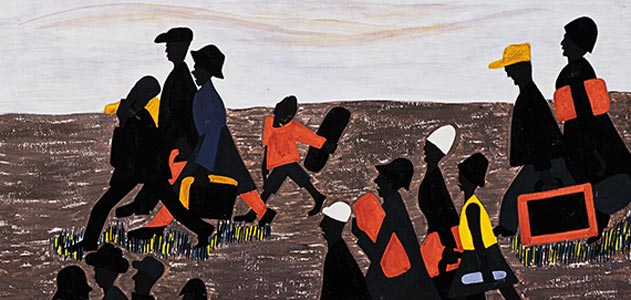 |
| From Jacob Lawrence's migration series, 1941 |
All that is true, but New York also offers sites and events that invite quiet reflection, that permit you to integrate some of all those stimuli into a coherent narrative. The New York Public Library, with all its branches, has always bee such a site, and I hope it will remain so — though we heard disturbing news of plans to sell off the branches (more valuable as real estate) and ship the books out to an out-of-city warehouse. Good people are fighting to save the libraries, and good people in New York have been able to accomplish many things, so maybe it'll all be all right.
Other great sites for reflection on where we are and what it all means include the great museums, the galleries and the theaters. We returned to Madrid yesterday after another week in New York, a city we know well — we lived there for over 30 years — and still recognize, though it is ever changing. And we took the opportunity to take in some shows at a couple of museums, several galleries and a theater: the Music Box, for the revival of Wendy Wasserstein's 1989 hit, "The Heidi Chronicles". Great production, terrific actors, in a very dated story that reminded us how far we have not yet come in women's struggle for recognition and equal opportunity.
In MoMA, we spent a lot of time at the exhibit Latin America in Construction: Architecture 1955-1980 — mainly because we've been working on a book that includes that period. Not, in our view, a totally successful presentation of such a complicated history — as Ronald Reagan famously noted, there are a lot of different countries "down there", and unless you already knew a lot about what you were looking at, you might not be sure whether a particular project or building was in São Paulo or Mexico, or 1952 or 1972, and some enormously important events (e.g., the coups in Chile and Argentina) were scarcely mentioned. But, if you did have some idea what you were looking at, you could find many fascinating, more obscure works that you hadn't seen before. Susana will be writing a more detailed review, so I'll leave my comments at that.
A totally successful exhibit (in my view) was the marvelous One-Way Ticket: Jacob Lawrence’s Migration Series and Other Visions of the Great Movement North. Seeing the entire series of Lawrence's 60 paintings, re-united for the first time in many years and set out on the four walls of a large gallery in the order he intended, was marvelous in many ways. First, the beauty of the pieces, in Lawrence's dramatic, flattened images in just four colors, emphasizing the stark reality of the great black migration from the southern to northern states of the U.S. in the years just before Lawrence was born (in 1917). And then, of course, that dramatic story, which the young Lawrence (he was only 23 when he painted the series) had thorough documented, by his readings in the collection on black history amassed by Puerto Rican-born scholar and bibliophile, Arturo Alfonso Schomburg, (now the Schomburg Center for Research in Black Culture, part of the wonderful resources of the New York Public Library,) and from his many conversations with his parents and other older neighbors in Harlem. The exhibit is further enriched by works by other artists, including the poet Langston Hughes (a friend of Lawrence, who illustrated Hughes's collection of poems with the same title as his series picture series, "One-Way Ticket"), a video of Marian Anderson singing at the Lincoln Memorial, another of Betty Holiday performing "Strange Fruit," and many other black musicians and graphic artists.
This I saw as a hopeful, optimistic picture of triumph, of people who and maintained and efended their dignity against the tremendous odds of color discrimination.
Some of their descendants have not given up or given in, and it's good to know that there are still rebels among them, defending their dignity and expressing themselves in new ways. But overall, the story told by the Met's exhibit is very sad one.